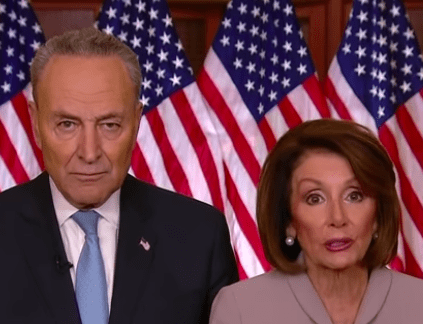Corporate Media Stoop to New Low in Shutdown Coverage
Recent fact checks of the president and his Democratic opposition reveal the absurd lengths to which our press will go to appear balanced. New York's Sen. Chuck Schumer and California's Rep. Nancy Pelosi respond to the president's national address on border security. (YouTube screen grab)
New York's Sen. Chuck Schumer and California's Rep. Nancy Pelosi respond to the president's national address on border security. (YouTube screen grab)
Last month, FAIR (12/7/19) examined the absurd false equivalence that some fact-checking sites, including the Washington Post’s Fact-Checker, sometimes engage in by comparing imprecise or accidental misstatements by left-wing politicians with the unprecedented and willful lies and conspiracy theories emanating from the current occupant of the Oval Office.
Coincidentally, the Post rolled out a new, even more extreme “Bottomless Pinocchios” rating (12/10/18)—which only Trump has qualified for, 14 times—three days after our post. And just this week, one of the targets of the Post’s false balance, Rep. Alexandria Ocasio-Cortez, addressed and linked to the column (cross-posted at Salon) on Twitter (1/7/19), to illustrate her comments about fact-checking during a recent interview on CBS News’ 60 Minutes (1/6/19).
With all that prologue, you might think mainstream news organizations would be on high alert about the trap of tendentious equivocation when it came to covering Trump’s prime-time immigration speech, and its Democratic response, on Tuesday night. But you would be wrong.
Barely an hour after the Democratic leaders Sen. Charles Schumer and Rep. Nancy Pelosi had completed their on-air response to Trump’s prime-time address, the New York Times (1/9/19) had published a fact-check story that stooped to ridiculous nitpicking. Of the eight statements analyzed by the Times, the lone Democratic example had all the earmarks of being shoehorned on to the end to create some semblance of balance. After quoting Schumer’s statement that the ongoing government shutdown was “hurting millions of Americans who are treated as leverage,” the Times countered by saying, “This needs context.” But what followed was a surreal example of fact-checking pedantry from the nation’s leading newspaper (emphasis added):
An estimated 800,000 federal workers are furloughed or working without pay because of the shutdown. While millions of Americans are not being directly harmed, there is a multiplier effect when considering family members of those whose jobs are affected. This also spills into the broader economy, harming business owners whose customers must cut back, tourism and travel.
Treating those federal workers who aren’t getting a paycheck as the only ones “directly harmed” by the ongoing shutdown is a shameful oversimplification, to say the least. To describe the families of federal workers who might go hungry because the federally employed member of their household has been furloughed—or worse, must work without pay—as a so-called “multiplier effect” is the very opposite of journalism’s comfort-the-afflicted ethos.
It also ignores the singular role the federal government plays in the life of our country and its citizens. Millions of Americans have already been put at risk from curtailed food and environmental safety inspections, reduced health care access in Native American communities, and the expiration of a low-income HUD program, which now threatens the housing status of thousands of people because of the shutdown.
All of this surreal narrative not-so-subtly flows from an impulse to imply that Democrats are exaggerating the shutdown’s impact in much the same way Trump is exaggerating the border crisis. This is both cruel and counterproductive “context” that muddies rather than clarifies. In effect, the paper’s blinkered, literalistic framing reinforces Trump’s fact-free spin on the shutdown, where he has claimed that any suffering is superficial and—without one iota of evidence—that the unpaid federal workers secretly support him.
But as bad as the Times’ fact check was, it paled in comparison to this jaw-droppingly stupid example from the Associated Press (1/8/19).
AP FACTCHECK: Democrats put the blame for the shutdown on Trump. But it takes two to tango. Trump’s demand for $5.7 billion for his border wall is one reason for the budget impasse. The Democrats refusal to approve the money is another.
The facile logic on display here is so untethered from any basic grounding in how political power works according to our Constitution that it might just float out into space. The warped framing effectively removes any of Congress’s agency in governing other than to rubber-stamp the President’s wishes. On Twitter, the AP’s tweet was quickly and mercilessly ratioed, as thousands of people cheekily responded with their own similarly vapid analogies. (Kidnapper-and-hostage scenarios were a popular choice.)
Of course, this “fact check”—pulled from a piece co-authored by AP’s Calvin Woodward, who has a long history of fact-check false equivalence—completely elides the fact that the government shutdown began while the Republicans still controlled both houses of Congress. In fact, the GOP-led Senate unanimously passed a bill funding the remaining portion of the government on December 19, but only after Trump abruptly changed his mind and signaled he would not sign that bill were it to reach his desk, did the Republican House (barely) pass a different funding bill that included appropriations for a border wall. That bill was dead on arrival in the Senate, and then the money ran out. In other words, the origins of the shutdown can be directly laid at the feet of the president’s own stubbornness and legislative bumbling.
Not to mention the fact that Trump publicly boasted about his desire to shut down the government in a bipartisan leadership meeting: “I will be the one to shut it down,” he declared in a meeting with Schumer and Pelosi (Politico, 12/11/18). “I am proud to shut down the government for border security.”
What’s more, the new Democratic majority in the House has already passed a government funding bill—albeit one different than the one passed by the Senate in the last Congress—so to imply it is equally to blame for obstructionism, when it is merely adapting to a legislative impasse it inherited, is ludicrous.
As the blowback to the AP’s inanity ricocheted across the Internet, the Washington Post’s media critic Erik Wemple sought out a comment from the wire service. AP’s response (1/9/19) manages the feat of both doubling down on the broken logic and incorrectly relating the facts on the ground, as detailed above:
The tweet was intended to point out that Democrats have refused to accede to President Trump’s demands, which preceded the president’s decision to refuse to fund the government without wall funding included.
In a tell-tale sign of damage control, AP (1/9/19) quickly issued a follow-up clarification to its first clarification of its fact check, again to Wemple:
The tweet was intended to make clear that Trump and Democrats have failed to find common ground in their disagreements, but it could have done a better job of explaining the dynamics that have led to the shutdown. The complete AP fact check was robust and focused almost exclusively on Trump’s comments.
Note this little dodge at the end; it is instructive. Both the actual AP (1/9/19) and Times fact-check stories included just a single example from the Democratic response. Perhaps not coincidentally, both of those strained, scrounging-for-anything examples turned out as flaming journalistic failures. This is not to say Democratic politicians don’t make factual mistakes in their rhetoric, or willfully lie on occasion; they obviously do. But the press’s determination to artificially package and elevate Democratic inaccuracies to help achieve partisan balance in coverage of Trump is a serious journalistic problem.
This nuance is lost on some in the fact-checking industry. For example, Sal Rizzo, who authored the misguided Post Fact-Checker column (12/4/18) on Rep. Ocasio-Cortez last month, resorted to a string of smarmy comebacks and straw-man arguments this week when earnest online critics challenged the way the press sometimes stoops to unfair equivalence when comparing Trump’s dishonesty and propaganda efforts to his political opposition:
- “(I don’t think they’re worried about the integrity of our Trump factchecks)” (1/8/19)
- “Democrats are never wrong/shouldn’t be factchecked” (1/8/19)
- “trying to but I keep getting rage tweets sted of something to study” (1/8/19)
- “the question stands for anyone who can handle some moxie” (1/8/19)
As FAIR noted last month, it will be worth watching how the corporate media treat Democrats once they return to power in the House. Sadly, just one week into that party’s control of the House, it looks as if the press is eager to put its thumb on the scale of reality when it comes to placing blame for the current dysfunction in Washington.
By no means should any Democratic efforts at misinformation be allowed to hide in the shadows next to Trump’s forest of falsehoods. But then, any forced effort to keep balancing them out will only make it that much harder to hold accountable both Trump and those who oppose him.
Your support matters…Independent journalism is under threat and overshadowed by heavily funded mainstream media.
You can help level the playing field. Become a member.
Your tax-deductible contribution keeps us digging beneath the headlines to give you thought-provoking, investigative reporting and analysis that unearths what's really happening- without compromise.
Give today to support our courageous, independent journalists.



You need to be a supporter to comment.
There are currently no responses to this article.
Be the first to respond.